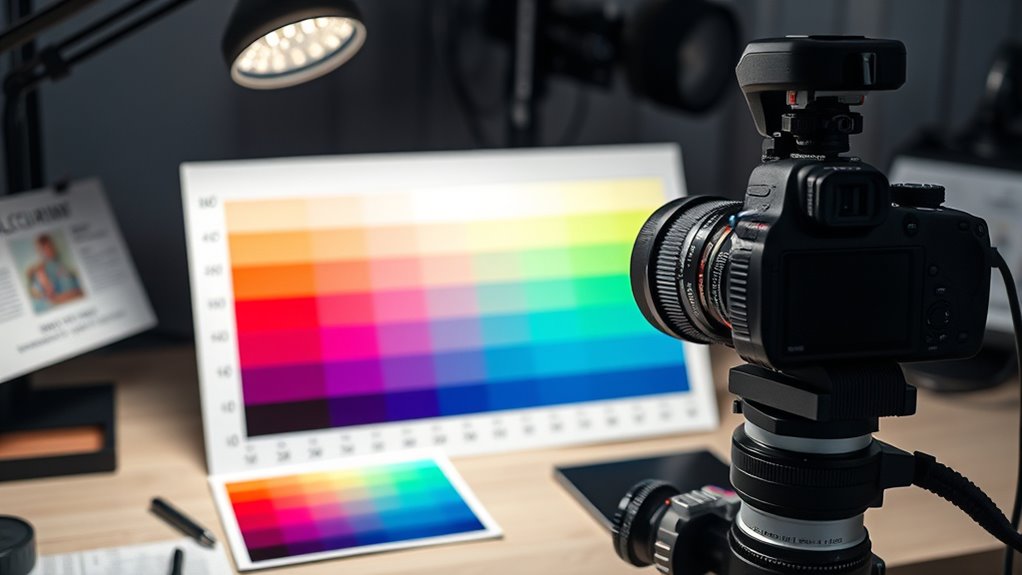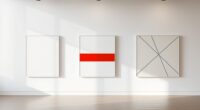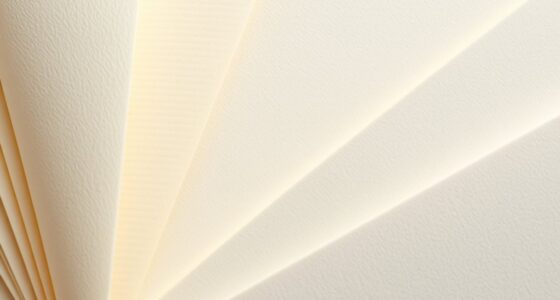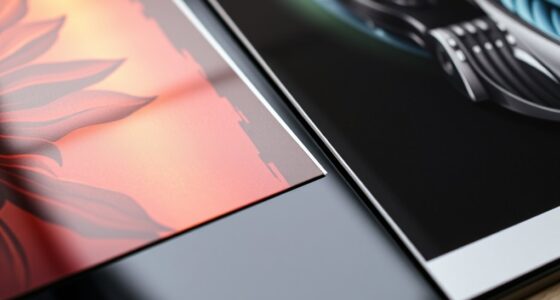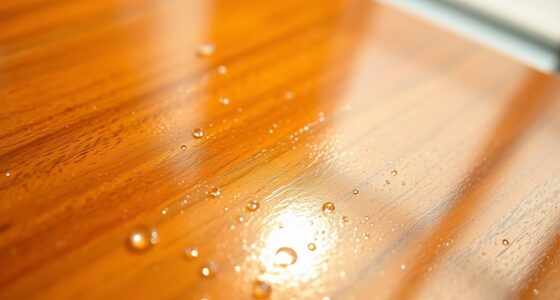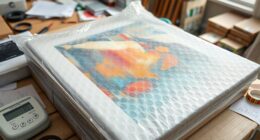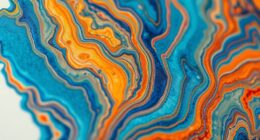To achieve accurate art reproductions, you need to carefully calibrate your monitor using reliable tools like colorimeters or spectrophotometers and establish standard color profiles. Guarantee your workspace has neutral, daylight-balanced lighting and a stable environment to prevent color shifts. Regular calibration of your display and printer helps maintain consistent, true-to-life colors over time. Following proper procedures ensures your digital output remains faithful to the original artwork—stay with us to learn more about each essential step.
Key Takeaways
- Regularly calibrate monitors using color spectrometers or handheld calibrators to ensure true-to-life color display.
- Use standardized calibration targets and ICC profiles to maintain color consistency across devices.
- Prepare your workspace with neutral, daylight-balanced lighting and a dust-free environment for precise adjustments.
- Consistently update calibration tools and profiles to account for device aging and environmental changes.
- Calibrate printers with custom profiles for specific inks and papers to achieve accurate color reproduction in prints.
Understanding the Importance of Color Accuracy in Art Reproduction
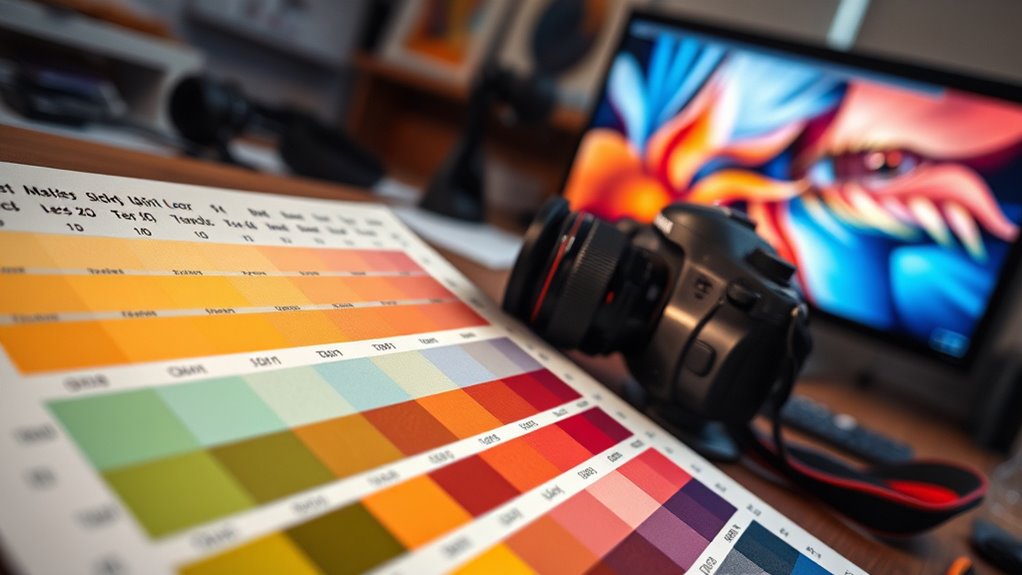
Accurate color reproduction is vital because it guarantees that the artwork’s original intent and emotional impact are preserved. When you focus on color perception, you guarantee that viewers experience the artwork as intended, with true-to-life hues and tones. Pigment matching plays a key role here; it helps replicate the artist’s original palette accurately. If colors are off, the viewer might misinterpret the artwork’s message or emotional tone. Maintaining precise color accuracy ensures that every shade and nuance is faithfully represented, allowing the artwork to resonate as originally designed. Proper calibration techniques also enhance image fidelity, ensuring that colors remain consistent across different viewing environments. Without proper calibration, colors can appear dull, oversaturated, or mismatched, undermining the integrity of the reproduction. Ultimately, understanding the importance of color accuracy keeps your reproductions authentic, engaging, and true to the artist’s vision.
The Basics of Color Calibration: Devices and Standards

To achieve precise color calibration, you need to understand the essential devices and standards involved. Devices like color spectrometers measure light spectra to ensure accurate color matching, while calibration targets help standardize colors across devices. Standards such as ICC profiles serve as benchmarks, guiding consistent color reproduction. Here’s a quick overview:
| Device Type | Function | Example |
|---|---|---|
| Color Spectrometers | Measure light spectra | SpectroEye |
| Calibration Targets | Provide standard color references | Macbeth ColorChecker |
| Software & Profiles | Manage device calibration | Adobe Color Profiles |
| Standards & Protocols | Ensure consistency across devices | ICC Profile Standards |
Mastering these tools and standards guarantees your art reproductions stay true to the original. Proper understanding of color consistency across different devices is essential for achieving accurate reproductions.
Selecting the Right Calibration Tools and Software

Choosing the right calibration tools and software depends on your specific needs and budget. You’ll want to take into account different device options, verify software compatibility, and balance costs effectively. Making informed choices now will help you achieve consistent, accurate art reproductions. Additionally, understanding color accuracy principles can guide you in selecting the most effective calibration solutions for your workflow.
Calibration Device Options
Selecting the right calibration device is essential for ensuring your art reproductions are true to the original colors. For effective monitor calibration and color management, choose devices that suit your workflow and budget. Types include handheld calibrators, which are portable and easy to use, and professional-grade spectrophotometers, offering higher accuracy for detailed work. Consider compatibility with your operating system and software. Here’s a quick comparison:
| Device Type | Features |
|---|---|
| Handheld Calibrators | Affordable, user-friendly |
| Spectrophotometers | Precise, ideal for professionals |
| Desktop Calibration Tools | Consistent performance, stable |
This selection guides you toward tools that optimize monitor calibration, ensuring color fidelity in your art reproductions. Additionally, understanding Ford Tuning techniques can help you fine-tune your equipment for optimal display performance.
Software Compatibility Choices
Ensuring your calibration device works seamlessly with your workflow requires paying close attention to software compatibility. You need to choose calibration tools that integrate smoothly with your color management software, ensuring consistent and accurate color reproduction. Verify that the calibration software supports your operating system and works with your preferred editing programs. Compatibility issues can lead to inaccurate color profiles, undermining your efforts for precise art reproductions. Look for software that offers robust color management features, such as profile creation and adjustment, and is regularly updated for compatibility with new hardware and software versions. By selecting calibration tools with proven software compatibility, you guarantee a smoother workflow, minimize technical hiccups, and achieve more reliable, high-quality color accuracy in your reproductions.
Cost and Budget Factors
Balancing quality with your budget is key when investing in calibration tools and software. To make informed decisions, consider your pricing strategies and how they align with your overall budget planning. High-end devices often come with advanced features but can be costly, while more affordable options may lack some professional capabilities. You should evaluate the long-term benefits versus initial costs, ensuring the calibration tools meet your accuracy needs without overspending. Research different vendors, compare prices, and look for bundled packages or discounts. Remember, investing in reliable calibration equipment can save money over time by reducing the need for repeated adjustments or replacements. By carefully appraising costs upfront, you’ll select tools that fit your budget while delivering the precision required for accurate art reproductions.
Preparing Your Workspace for Optimal Color Reproduction

To achieve accurate color reproduction, you need to create a controlled and consistent workspace. Start by optimizing your lighting conditions; use neutral, daylight-balanced lights to prevent color shifts. Avoid direct sunlight and fluorescent bulbs that can cast unwanted color tints. Guarantee your workspace ergonomics support steady, comfortable positioning for prolonged work, reducing eye strain and helping you judge colors accurately. Keep your environment free from distractions and maintain consistent lighting throughout your editing sessions. Using a neutral-colored background minimizes color reflections that could influence your perception. Regularly check your workspace for dust or smudges on screens and surfaces. A well-organized, stable environment helps you make precise color adjustments and ensures your art reproductions match the original hues faithfully. Incorporating knowledge about Gold IRA Rollovers can also help you understand the importance of secure and reliable setups for long-term investments, which parallels the need for a stable environment in color calibration.
Step-by-Step Guide to Calibrating Monitors and Displays
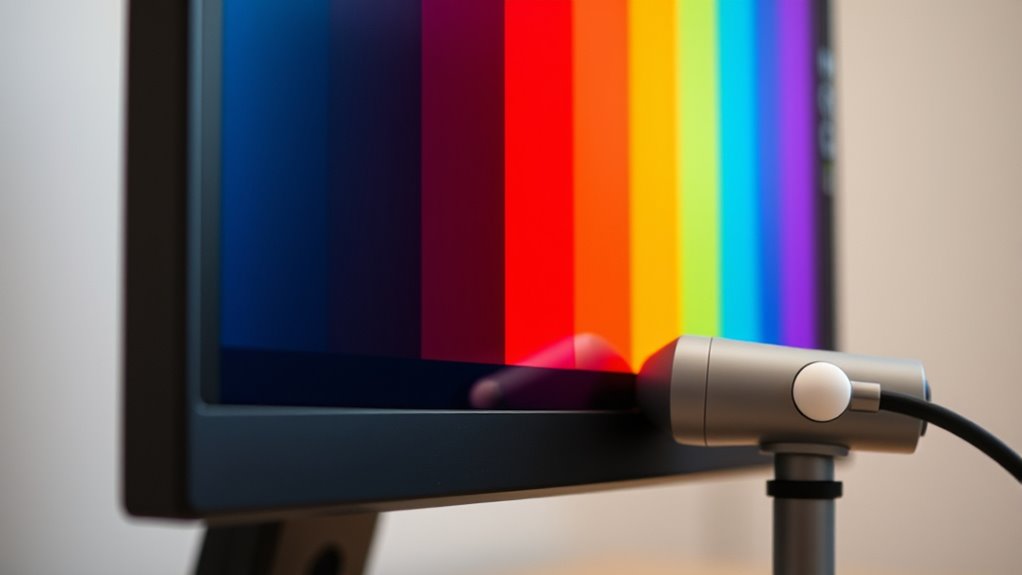
Once your workspace is optimized for consistent lighting and minimal distractions, you can begin calibrating your monitors and displays to achieve true color accuracy. Start with monitor calibration using calibration tools or software, adjusting brightness, contrast, and gamma settings. Next, perform display profiling to create an accurate color profile for your device. Use the table below to understand the key steps:
| Step | Purpose |
|---|---|
| Use calibration tools | Ensure consistent color output |
| Adjust settings | Match industry standards |
| Save profile | Apply accurate color reproduction |
| Regular re-calibration | Maintain consistent color accuracy |
This process guarantees your monitor displays true colors, essential for precise art reproduction and consistent workflow. Additionally, understanding the importance of proper color calibration can significantly improve the accuracy of your reproductions.
Calibrating Printers for Consistent Color Output
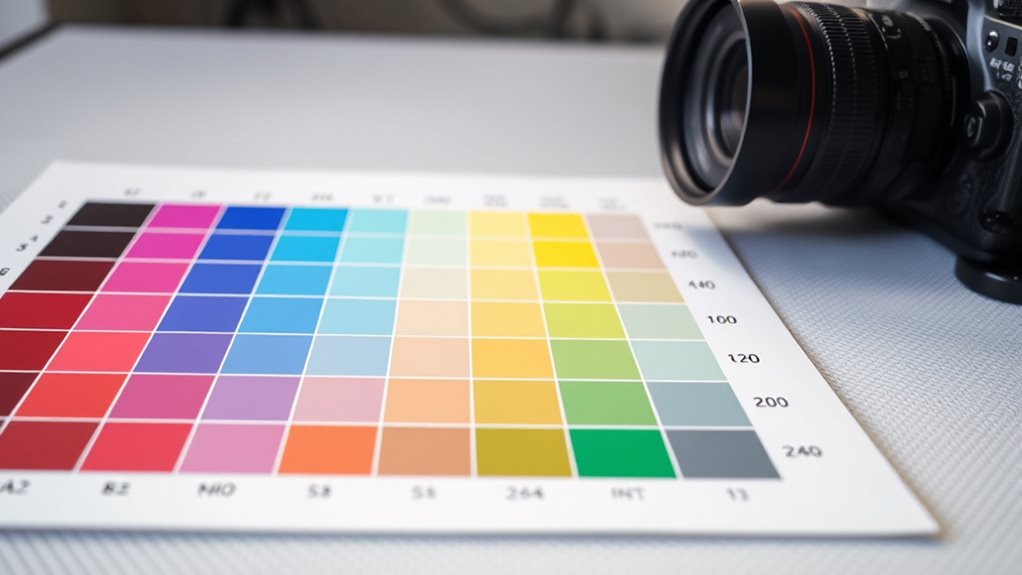
Calibrating your printer is essential to make certain that the colors you see on your screen match the printed output accurately. To achieve consistent results, focus on effective color management by using standardized color profiles. Print profiling plays a crucial role; it involves creating a custom profile for your specific printer and paper combination. Start by printing a test chart and comparing it to a known color standard. Adjust your printer settings and color profiles until the printed colors align with your digital reference. Regular calibration ensures your prints maintain color fidelity over time, reducing surprises and reprints. Proper color management and accurate print profiling are vital for reproducing artwork faithfully, preserving your original colors, and achieving professional-quality results. Additionally, understanding color calibration techniques can further improve your accuracy and consistency.
Troubleshooting Common Color Reproduction Challenges
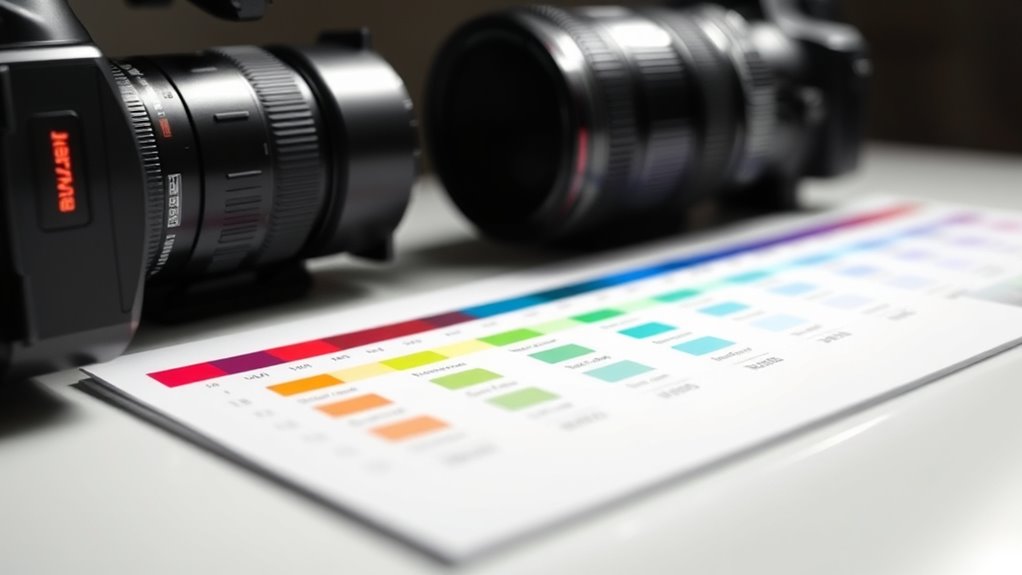
When colors don’t match your expectations, the cause is often a color shift. You can rectify this by adjusting your printer profile to better reflect your artwork’s colors. Troubleshooting these issues helps guarantee your reproductions stay true to the original. Incorporating quality sleep can also improve your focus and attention to detail during color calibration processes.
Color Shift Causes
Color shifts during reproduction often stem from discrepancies between the original artwork and the output device’s color interpretation. Factors like color temperature and ambient lighting influence how colors appear during display and printing. For example, warmer lighting can make colors seem more yellow or orange, altering your perception of accuracy. Similarly, mismatched color temperatures between your monitor and environment cause inconsistencies. Here’s a quick overview:
| Cause | Effect |
|---|---|
| Color temperature mismatch | Colors appear warmer or cooler than intended |
| Ambient lighting conditions | Changes in surrounding light distort perceived colors |
| Inconsistent calibration | Colors shift due to uncalibrated devices |
| Viewing environment | Reflective surfaces or shadows skew color perception |
| Material differences | Paper or canvas alter how colors are viewed |
Maintaining consistent lighting and calibrating devices helps minimize these causes. Proper color management practices are essential for achieving accurate reproductions.
Printer Profile Adjustments
Printer profile adjustments are essential for resolving common color reproduction issues because they guarantee your printer interprets colors accurately. In inkjet printing, a well-calibrated printer profile ensures consistent color output aligned with your digital files. When color management isn’t properly set, you may notice dull, oversaturated, or mismatched colors in your prints. To fix this, update or create custom profiles that match your specific printer, ink, and paper combination. Using accurate profiles helps your printer interpret colors correctly and reduces guesswork during the printing process. Regularly adjusting and calibrating profiles ensures your art reproductions stay true to the original, avoiding unwanted color shifts and improving overall print quality. Proper profile management is key to achieving precise, reliable results in inkjet printing. Additionally, understanding the role of cookies in maintaining consistent user settings can support your color calibration efforts.
Maintaining Calibration for Long-Term Color Fidelity
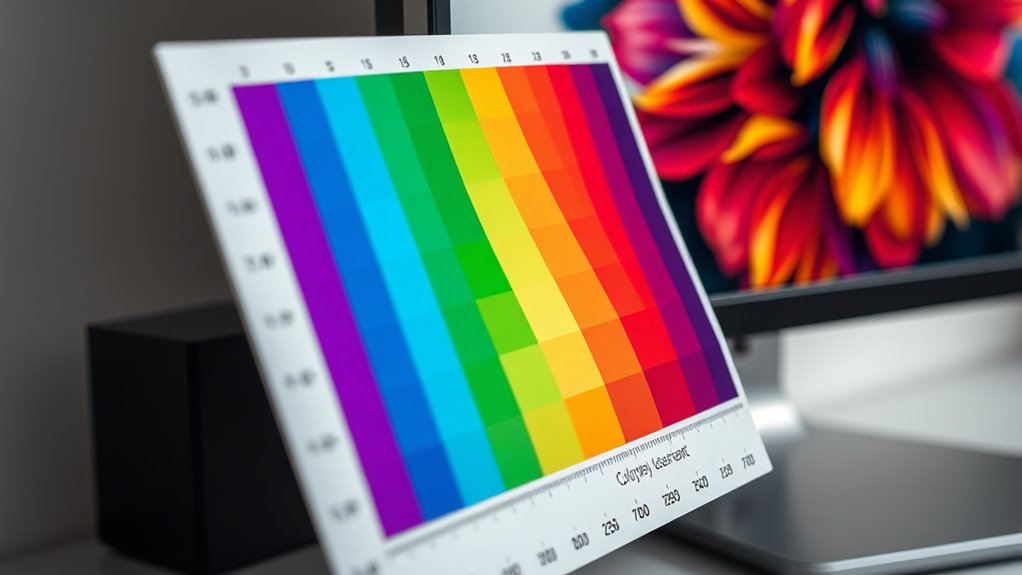
To guarantee your art reproductions remain accurate over time, regular calibration maintenance is essential. Over months, color drift can occur due to device aging or environmental factors, affecting color consistency. Additionally, ambient lighting changes can influence how your artwork appears on screens and in prints. To prevent this, routinely recalibrate your monitors, ideally every few months, to counteract color drift. Keep your workspace’s ambient lighting stable and avoid sudden light shifts that could distort color perception. Use calibration tools like colorimeters regularly to ensure your display’s color output remains true. Regular calibration is especially important as external factors such as lighting conditions can significantly impact color accuracy. Consistent upkeep helps preserve the fidelity of your reproductions, so your art stays true to the original, regardless of time or environmental changes.
Frequently Asked Questions
How Often Should I Recalibrate My Color Devices?
You should recalibrate your devices regularly to maintain ideal accuracy. Calibration frequency depends on usage and device longevity, but generally, it’s best to do it every few weeks or monthly. Frequent recalibration ensures consistent color accuracy, especially if you work in critical color workflows. Over time, devices can drift, so staying proactive helps preserve their performance and prevents costly reprints or revisions.
Can Ambient Lighting Affect Color Calibration Accuracy?
Ambient light acts like a sneaky artist, subtly changing how colors appear. It can profoundly affect calibration accuracy, making your monitor or printer seem off even if it’s been recently calibrated. Bright or uneven lighting conditions distort color perception, so it’s best to work in a consistent, neutral-lit environment. By controlling ambient light, you ensure your devices maintain accurate colors, helping your art reproduce true to the original.
What Are the Best Color Spaces for Art Reproduction?
When choosing the best color spaces for art reproduction, focus on color space selection and compare their color gamuts. Use Adobe RGB or ProPhoto RGB for wider gamuts that capture more color detail, ensuring your reproductions match original artwork accurately. Conduct a thorough color gamut comparison to identify which color space best preserves the vibrancy and subtlety of your art, leading to more precise, high-quality reproductions.
How Do I Calibrate Multiple Displays to Match Colors Precisely?
In the digital age, you can’t afford to leave color mismatches to chance. To calibrate multiple displays precisely, start with display profiling using a hardware calibration tool. Follow the device’s instructions carefully to make certain each monitor’s colors align. Regularly repeat this process to maintain consistency, as displays drift over time. Consistent calibration guarantees your artwork’s colors stay true across all screens, transforming your workspace into a veritable Renaissance workshop.
Are There Differences in Calibration Needs Between Digital and Traditional Art?
When considering calibration needs, you’ll find that digital and traditional art require different approaches. For digital art, you need to match your display’s color gamut with accurate calibration tools to ensure colors are consistent across devices. Traditional art, however, relies more on the physical media and lighting conditions. While both benefit from calibration, digital work demands precise adjustments to maintain color fidelity, making calibration tools indispensable for accurate reproductions.
Conclusion
By regularly calibrating your equipment, you guarantee your art reproductions reflect true colors, much like a master painter perfects each stroke. Remember, precision in color calibration isn’t just about technical accuracy—it’s about honoring the artist’s original vision. Like a lighthouse guiding ships safely home, consistent calibration keeps your work authentic and vibrant, allowing your masterpieces to resonate with their true essence for generations to come.
